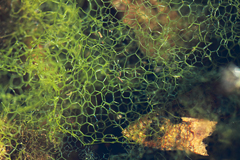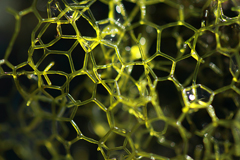Plants of the Gila Wilderness
Presented in Association with the
Western New Mexico University Department
of Natural Sciences
Hydrodictyon sp.
Thanks to Dr. William R. Norris for the following information:
The genus name “Hydrodictyon” has a Greek origin (“hydro” + “dictyon”), and literally means “Water Net” (Bold and Wynne 1985). The first written record of an alga might have been a reference to water net in Chinese literature (Prescott 1978). This green alga consists of a colony of cylindrical cells that adhere to one another to form polygons. This colony is referred to as a “coenobium” (Graham et al. 2009). A typical polygon in Hydrodictyon is five or six-sided (Wehr and Sheath 2003), but cells can join to form polygons with between three and nine sides (Bold and Wynne 1985). No other green alga in the United States forms has this net-like appearance (Prescott 1978).
Each cell in a Hydrodictyon coenobium is cylindrical, multinucleate, and contains a large central vacuole (Graham et al. 1999). A single, highly branched chloroplast and many pyrenoids can be found inside each cell (Lee 1999). Water net can reproduce both asexually and sexually. In asexual reproduction, a daughter net is formed inside and eventually released from the parent net (Lee 1999). In sexual reproduction, flagellated gametes are shed into the water by the parent cells, where they fuse to form zygotes. These zygotes undergo meiosis to form four flagellated spores, which each eventually settle and germinate into polyhedral (= multi-sided) cell which ultimately develops into the characteristic net (Bold and Wynne 1985).
Hydrodictyon occurs in temperate to tropical regions (Wehr and Sheath 2003) and can be found in lakes, ponds, rice paddies, fish farms, slow-flowing streams, and irrigation ditches (Bold and Wynne 1985, Prescott 1978). It can become weedy and totally cover the surface of small ponds and lakes. Water net has also been known to clog boat engine intakes (Graham et al. 2009).
Bold, H.C. and M.J. Wynne. 1985. Introduction to algae. Prentice Hall, Inc., Upper Saddle River, NJ. 720 p.
Graham, L.E., J.J. Graham and L.W. Wilcox. 2009. Algae, 2nd ed. Benjamin Cummings, New York, NY. 616 p.
Lee, R.E. 1999. Phycology, 3rd ed. Cambridge University Press, Cambridge, UK. 614 p.
Prescott, G.W. 1978. How to know the freshwater algae. Wm. C. Brown, Publishers. Dubuque, IA. 293 p.
Wehr, J.D. and R.G. Sheath. 2003. Freshwater algae of North America: ecology and classification. Academic Press, New York, NY. 918 p.
Please click on an image for a larger file.

Hydrodictyon species, photo Russ Kleinman, Sycamore Canyon near Cliff, November 8, 2010

Hydrodictyon species, 1x field macro, photo Russ Kleinman, Sycamore Canyon near Cliff, November 8, 2010
Back to the Index

